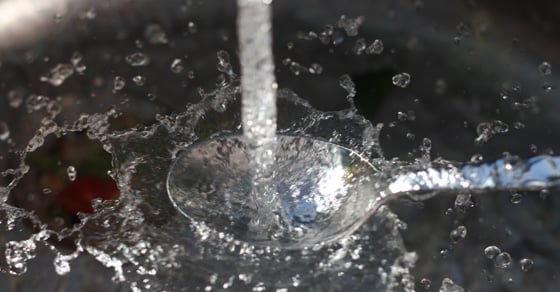Activated carbon is a widely used adsorbent, employed throughout a variety of industries to accomplish a number of goals. Activated carbon’s unique porous surface structure allows it to capture and hold on to both gas and liquid phase particles. This ability lends itself to a wide range of applications, not the least of which, is pulling contaminants from water in water treatment efforts.
Activated carbon has long been used to remove undesirable components from water. However, a developing application for activated carbon in water treatment is gaining attention: controlling disinfectant by-products in drinking water.
What are Disinfectant By-Products
The 1989 EPA Surface Water Treatment Rules (SWTR) aimed to reduce illness-causing bacteria in drinking water. This resulted in an increased use of disinfectants to treat surface water systems.¹ Disinfectants are now widely used in public water treatment systems to protect against these harmful forms of bacteria.
While the implementation of disinfectants in water treatment made huge strides in protecting the public from various waterborne illnesses, it has proven to present problems of its own; these disinfectants have been found to react with components in the water to form undesirable, hazardous compounds, referred to as disinfectant by-products, or DBPs. The EPA now regulates a variety of DBPs. Among them:
- Trihalomethanes (THMs)
- Haloacetic acids (HAAs)
- Chlorite
- Bromate
According to the EPA, studies have linked DBPs to certain cancers, and more recently, potential reproductive and developmental issues. As such, EPA regulation aims to minimize exposure to DBPs, while still protecting the public from disease-causing bacteria and pathogens that can be found in water. EPA guidelines regarding DBPs can be found under Stage 1 and Stage 2 Disinfectants and Disinfection Byproducts Rules.
Activated Carbon in DBP Precursor Removal
Many methods exist for managing DBPs, with most focusing on either finding an alternative method of disinfection or removing the precursors for DBPs.
While the use of alternative disinfection methods such as ozone, chlorine dioxide, or chloramines may result in lower concentrations of THMs and HAAs compared to free chlorine (a widely used disinfectant), these alternative methods can result in the formation of other DBPs. For example, when ozone is used as an alternative disinfectant, it can react with bromide to form bromate. Similarly, the use of chlorine dioxide can result in the formation of chlorite. Furthermore, not all alternative disinfectants are as effective as chlorine at treating water.²
For this reason, it often makes sense for water treatment facilities utilizing chlorine as a disinfectant to focus on removing the precursors of THMs and HAAs.
The Water Research Foundation and the EPA recognize Granular Activated Carbon (GAC) as an effective approach for removing DBP precursors, namely natural organic matter (NOM), in order to reduce the opportunity for DBP formation.
After examining several other approaches, including ozone-biofiltration, continuous ion exchange, and nanofiltration, Cobb County-Marietta Water Authority (CCMWA) chose to go with granular activated carbon for controlling DBPs in their water treatment process.
Activated carbon suited the requirements of their facility best of all the examined methods, and was a fit for both current and potential future regulations on DBPs, making it an attractive option. Activated carbon was also chosen for the ease of integration it offered with their current setup, its operational flexibility, maintenance and operational costs, and because this approach did not produce excessive amounts of wastewater.
Activated Carbon Reactivation
One of the benefits of granular activated carbon is that it is reusable; the adsorbed components can be desorbed, typically through the use of a rotary kiln, rendering the carbon again activated and ready to serve as an adsorbent. Reactivation is more cost effective and has a smaller environmental footprint over new activated carbon.
Regeneration can be carried out by sending the material back to the manufacturer, submitting to a carbon pool, where companies pool together their spent carbon to cut costs, or through an on-site regeneration facility.
On-site regeneration may be preferred for remote facilities where shipping costs would be high, or facilities that are running high volumes.
Conclusion
Activated carbon is a multi-faceted adsorbent that serves as a key tool in many water treatment efforts. And while it has long been used in the water treatment industry, its application in protecting the public from disinfectant by-products through the removal of DBP precursors proves to offer an effective solution to this newly-emerged challenge. As water treatment becomes increasingly important, activated carbon is likely to continue to play an integral role.
FEECO provides custom rotary kilns for the production and regeneration of activated carbon. For more information, contact us today!
Sources:
1.United States. Environmental Protection Agency. Office of Groundwater and Drinking Water Technical Support Center. Disinfectants/Disinfection Byproducts – Rules and Requirements. N.p., 5 Nov. 2015. Web. Jan. 2017. <https://www.epa.gov/sites/production/files/2015-11/documents/c15-gsmith-p1.pdf>.
2.United States. Environmental Protection Agency. Office of Water. EPA.gov. N.p., Dec. 2005. Web. Jan. 2017. <https://nepis.epa.gov/Exe/ZyPDF.cgi?Dockey=P100LZ09.txt>.



